This article describes how to sync your inventory between your eCommerce and point of sale platforms.
Before You Start Syncing Your Inventory
After you've connected your point of sale and eCommerce platforms to SKU IQ, you'll be ready to sync your inventory between the two. Inventory quantities will not automatically sync until you've either linked existing products between the two platforms or migrated (pushed) products from one side to the other. Pushing a product from your eCommerce or point of sale to the opposite side (point of sale or ecommerce, respectively) will automatically link the products together without having to use the link report. We'll discuss the link report in more detail in just a moment.
You may also want to do some data maintenance prior to syncing your inventory. Check out this article on how to clean up your data for some handy tips and tricks on data cleaning and maintenance.
Not sure you should be Linking or Pushing? Check out this article on Linking Versus Pushing to help you decide.
🚨 Note: inventory quantities are the only product data type that will sync by default. If you did not choose which additional fields to sync during your initial setup, don't worry! We can add those on at any time for you. You can see what other data types (e.g. prices, titles, descriptions, etc.) by taking a look at the integration charts and narrowing down by your specific platforms. If you see a product data type you'd like to sync in addition to your quantities, send an email to our support team so that they can enable those for you. Not sure what the product attributes mean? Check out this article that explains them in detail!
🚨🚨WARNING: If you have not already done so, make sure to turn Inventory Tracking on for Clover, Square, or Shopify.
Linking Products
If you have products that exist on both your point of sale and eCommerce the first step to getting your products talking together is to link them! Linking products permits SKU IQ to communicate inventory quantities between the point of sale and eCommerce site in real time as sales are made and purchase orders are received. This allows you the peace of mind to not sell out of products and cause customer frustration and disappointment.
If you need a little bit more in-depth discussion on how to use the Link Report, check out this article.
How do you link products?
You may have seen the link report during the initial setup wizard, but perhaps you didn't see matches of products that you know should match. There are three ways that SKU IQ matches products together:
- By Product Title
- By SKU Number
- By UPC Number (AKA Barcode)
If there are products that do match based on the above factors but don't come up on the link report, these may be the reasons why:
- Product titles match, but the price of the products may be different
- Products do not have the same structure between the two platforms (meaning that a non-variable product is trying to match with a variable product). Products must have the same structure between both platforms.
- There may be a special character (e.g. - _ ; :) that are preventing matching between the two products
- There may be an alphanumeric mismatch. While SKU IQ is capable of matching without being case sensitive, it is sensitive to spelling.
SKU IQ will generate a Link Report for you once you've successfully connected your point of sale and eCommerce website and the import of products has completed. If you need to generate a new one, it's very simple!
1. Just navigate to the Link Report tab on the left hand side of the dashboard.
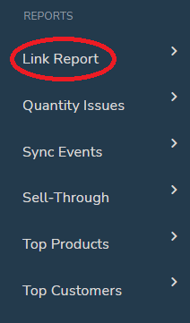
2. Click the "Refresh Report" link on the right hand side.

💡Tip: If you have a lot of inventory, the generation of the link report may take a little while. Not to worry though! You don't have to sit and wait - we'll email you when the report has finished generating!
What do you do once the link report is generated?
The link report is used to match products together that already exist on both platforms. In order to communicate quantities and other product data between your point of sale and eCommerce, products do need to be linked together. Unlinked products will not have the ability to sync quantities or product data. Once you have linked a product, the inventory will adjust to the primary system that was selected and unify your inventory quantities.
💡Tip: We recommend linking a test product first to ensure that you're comfortable with the syncing capabilities of SKU IQ. You can use the SKU IQ Test item that is generated during the Setup Wizard if you would like.
To use the link report, follow these steps:
1. Navigate to the Link Report on the left hand side of the Dashboard

2. The link report should look like this:

🚨NOTE: If your link report looks like this:
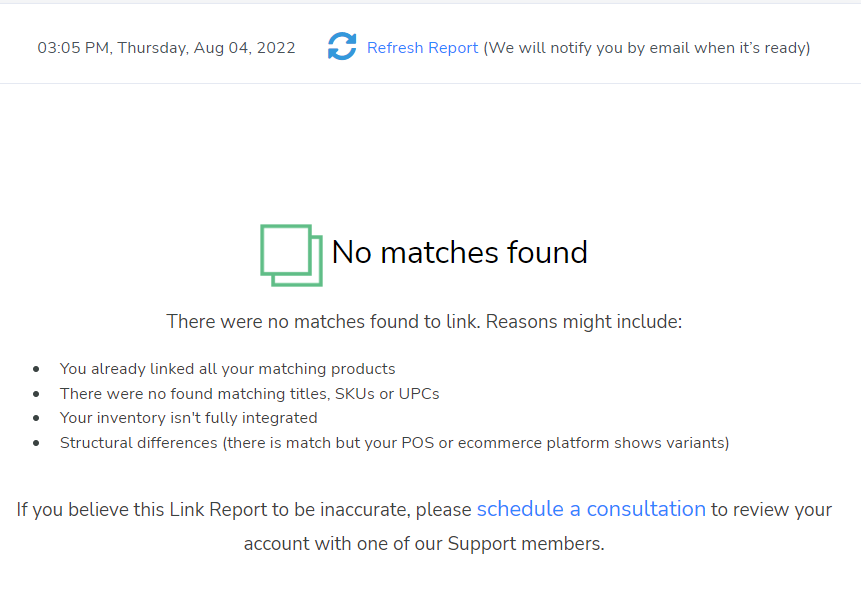
Go to how to regenerate a link report. That section will show you how to generate a new link report.
3. You'll have the option to select which inventory quantity is correct - either the point of sale or your eCommerce. In this case, Lightspeed is the point of sale (the red icon) and Wix is the eCommerce. You'll notice that both sides have the same quantity. This may not be the case for all merchants. You will want to pick the inventory quantity you know is correct - this is your primary system. If you need to do an inventory count, that's okay. Once the products are linked together, you can update the quantity values on either platform and the quantity will update on the other side as well.

Make sure to check the checkbox to the left hand side as well.
4. If you know that your point of sale or eCommerce inventories are correct and you want to select all, you can click the respective button under Primary System to select all 100 items on the first page.

🚨 NOTE: Selecting one of the primary system buttons will only select the first 100 items that can be linked. If you would like to link all of your items (if you have more than 100 to link) at once, please contact our support team to have them process a bulk link. (A bulk link allows us to link all of your products together on the backend so you don't have to go page-by-page.) You will need to let them know which platform to respect as the Primary System as well.
By clicking a primary system button, this will also automatically check all of the boxes for the items on that page.
5. Scroll down to the bottom of the page and click on Link Items

6. A popup window will come up asking if you would like to link the items you have selected.
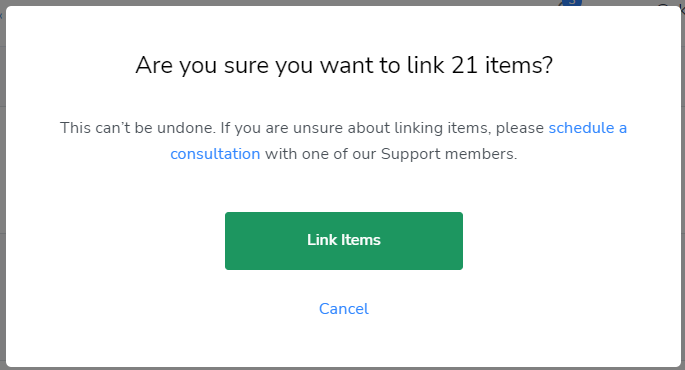
If you're sure you want to link the items, you can click on Link Items in the popup window. If you have questions, or aren't sure, contact support so that they can answer your questions.
7. The items you've selected will now link. This process is relatively quick, but can take up to 2 minutes per product to link. A whole page of 100 items can take approximately 30 minutes to finish linking. You can continue to link the remaining pages, going page by page, or you can contact support for a bulk link. (A bulk link allows us to link all of your products together on the backend so you don't have to go page-by-page.)
8. You can see products that are linked by navigating to Products on the left hand side of the Dashboard
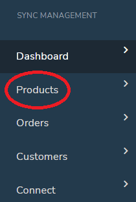
Use the Filter dropdown menu to select In-store & Online
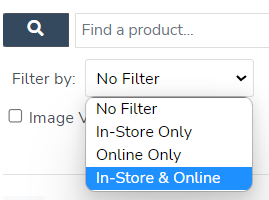
Items that are linked together will have both the point of sale and eCommerce icons next to them as well as a blue icon of circular arrows (AKA the Linked Icon).

Troubleshooting Linking Products
In order to link products between your point of sale and eCommerce platforms, products must meet the following requirements:
1. Products must be listed on both platforms. If you have a new point of sale or eCommerce system with no products entered yet, you do not need to link products. You can, instead, push them to migrate them over to the opposite platform. See pushing products for more information.
2. Your point of sale and eCommerce products must have a common SKU number, UPC or Barcode number, or product title.
🚨NOTE: If the product titles are the only data type that match between platforms, the products must also have a matching brand and price in order for SKU IQ to detect the match. The brand field can be blank on both sides.
3. Products must have the same structure between both platforms in order to be matched. This means that each item must either be a parent product with variants OR be an individual product with no variants on both platforms. In the image below, the point of sale shows an item with variants (also known as a matrix for Lightspeed users) while the eCommerce platform shows the same items listed as separate items. Although they may be considered the same product, SKU IQ requires that both products have the same structure in order to be linked.
4. Products may not be duplicated in your point of sale or eCommerce platform. Each item must be individualized either with a unique product title, UPC, or SKU number.
5. Products must not have duplicated variants.
6. Products that you want to link must be in active (published) status and not in achieved or draft status.
In order to fix products that are not linkable, you can do one of the following:
- Archive the product that has a mismatched structure and create a new product on the platform that had the mismatched structure on it.
- Delete the item(s) from one platform (ideally the one that has the incorrect structure) and push the product from the correct platform to the other. See #pushing products section below.
- Edit the products within your point of sale or eCommerce so that they have matching attributes and matching structures. This option is not ideal as some integrations do not translate variants very well. Check the integrations pages to see if your platforms can perform this task. If you only need to add a SKU or UPC number, this option is okay to use.
💡Tip: If you have made multiple edits to multiple products, you may need to contact support in order to perform a reimport of your product catalog so that SKU IQ can reflect the latest changes.
Pushing Products
Pushing your products is a neat and handy way of copying an item from one platform to the other so that they can both be sold in-store and online. When a product is pushed from one platform to the other, those items are automatically linked together and inventory quantities will be instantly synced. You can push products from your Point of Sale to your eCommerce and vice versa. If you'd like some more in-depth information, check out this article!
💡 Tip: If you have the same products on both platforms, you should link your products instead of pushing them to avoid duplication.
Not every data type will sync between the two platforms. You can check to see what data types will sync by checking the integrations pages.
When you first connect your point of sale and eCommerce platforms to SKU IQ, your In-store and Online items will populate in the Inventory list under the Products page. You can use the Filter By dropdown menu to narrow down what items you see, especially if you have linked items.
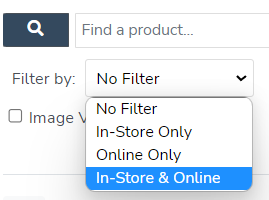 Linked items will show up under In-Store & Online while items that are only on the Point of Sale will show up under In-Store Only and items that are only on the eCommerce website will show up under Online Only. No Filter will show all products, including those that don't exist on either platform and only exist on SKU IQ. You can also use the Hide Sold-Out checkbox to further narrow down your items so that you only push items that have positive stock quantities.
Linked items will show up under In-Store & Online while items that are only on the Point of Sale will show up under In-Store Only and items that are only on the eCommerce website will show up under Online Only. No Filter will show all products, including those that don't exist on either platform and only exist on SKU IQ. You can also use the Hide Sold-Out checkbox to further narrow down your items so that you only push items that have positive stock quantities. 
This is how to push items once you've filtered down where you want to be.
1. Click the checkboxes next to the items you want to send to the other platform

Each page contains 50 items. You can select all by clicking the checkbox at the very top of the list.

2. A black Actions button will appear at the top of the product list. When you click the button, a dropdown menu will appear giving you the option to Push to POS or Push to eCommerce.
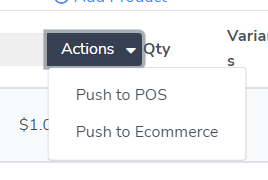 If you are pushing items from your point of sale, you will want to select Push to eCommerce. If you are pushing items from your eCommerce site, you will want to select Push to POS.
If you are pushing items from your point of sale, you will want to select Push to eCommerce. If you are pushing items from your eCommerce site, you will want to select Push to POS.
💡Tip: You may want to start with one product to test with to ensure that you are comfortable with the syncing capabilities and the data that is migrated.
3. Once you have selected Push to POS or Push to eCommerce, a popup will appear letting you know you are about to push a specific number of items to the respective platform.
When you're ready to go, click on Cool, do it!
4. Each product can take a few minutes to send over to the other platform. 50 products typically takes 60 minutes to finish. New products you've pushed can take up to one hour to display on the other platform's dashboard depending on the polling time of the product. You can see more information about polling times #here.
🚨NOTE: During your free trial you are limited to pushing a maximum of 50 products from one platform to the other. Once you have signed up for a paid subscription, there is no longer a limit on how many items can be pushed. However, only 50 items can be pushed at a time (meaning 50 items per hour). If you'd like to have SKU IQ do a bulk push (where we push all of your items for you on the backend), please contact support for pricing and more information.
5. After your products are pushed, you can view them by going to Products and filtering to In-Store & Online. You'll see both the point of sale and eCommerce icons as well as the blue linked icon for the products that have been pushed over.

Troubleshooting Product Pushing
Sometimes products will fail to push over from one platform or the other. Generally speaking, an error message will be generated for you to see what exactly went wrong. These error messages can range from duplicated products or variants, to server time outs, or a product having too many variants. This part of the article is not exhaustive of what kinds of error messages you will run in to while pushing products. For any error message you aren't sure about, please contact support immediately.
Duplicate Products
If you have items named exactly the same, these items can fail to push from your Point of Sale to your eCommerce platform or from your eCommerce platform to your Point of Sale. Product title (name) is one of the unique identifiers that both Point of Sale platforms and eCommerce platforms use to identify an item. Changing the title of the product is often enough to send the product over. You will notice in the above image that the Perfect T-Shirt has one version that has 3 variants and one version that has 1 variant. This can be because a 4th variant was added in as a separate item. This can easily be fixed by archiving or deleting the product with the lone variant and adding that variant to the product with 3 variants.
Duplicate Variants
This is an example of what an error will look like where a duplicate variant exists. In this case, the variant Red/13 already exists. This can happen when an item that already exists is entered again, like below:
In order to resolve this problem, either the color or size field needs to be changed. Many of the platforms we work with will only recognize the Color or Size fields as differentiators for variants. Custom fields like Grade, Condition, Weight, etc. cannot be used to differentiate the variant.
Server Timeouts
Server timeouts can happen for many different reasons. The one that we typically run in to at SKU IQ involves rate limits. Rate limiting is a strategy used by many corporations to limit incoming network traffic. It puts a cap on how often an action can be repeated within a specific timeframe, like logging in to an account or sending information back and forth from SKU IQ to your Point of Sale or eCommerce platform. These activities - also known as calls - can overload web servers if there are too many performed at once. This can lead to outages and thus customer disappointment. In order to prevent this from happening, each Point of Sale and eCommerce platforms have a number of operations they can handle. If you run in to a server time out, it is likely that we have tried to perform too many actions on your behalf and we need to wait to continue.
| Point of Sale | eCommerce |
| Clover has a hard limit 50 calls/sec | BigCommerce has tiers ranging from 5 calls/sec to unlimited calls |
|
Lightspeed Retail offers tiers of 1 call/sec to 3 calls/sec |
Shopify offers two tiers of 2 calls/sec to 4 calls/sec |
|
Square does not publicly disclose their rate limit |
Wix has a hard limit of 3 calls/sec |
| Vend calculates their limits per register, but is roughly 1 call/sec | WooCommerce is dependent on the limits that you have chosen for your website itself and upon the hosting service's limits. |
If you've run in to a server time out, you may need to consult with your platform to see what rate limits you have for your given plan.
Product Has Too Many Variants
Almost all of the platforms we work with have limits on how many variants you can have per product. Some have a limit on how many products you can have. See these charts for the limits of each platform.
| Point of Sale Platforms | Product Limit | Variant Limit |
| Clover | 15,000 Products (recommended limit) |
No Limit |
| Lightspeed Retail | No Limit | No Limit |
| Square | 25,500 Products | 250 Variants per product |
| Vend | No Limit | No Limit |
| eCommerce Platform | Product Limit | Variant Limit |
| BigCommerce | No Limit |
600 Variants per Product |
| Shopify | No Limit | 100 Variants per Product |
| Wix | No Limits | 1000 Variants per Product |
| WooCommerce | 1,000,000 Products | 50 Variants per Product |
💡 Tip: Variants are only available on Clover Register plans, NOT on the payment-only plans.
To avoid the error message that there are too many variants per product, please make sure to keep to the constraints of both of your platforms. To fix this problem, you will likely need to break up the item on the source platform to fit the constraints of the other platform.
If you need more troubleshooting help, check out this article or reach out to Support.
